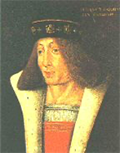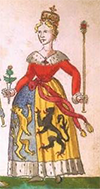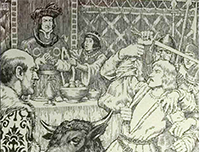King James II of Scotland
James II of Scotland had a turbulent life and reign, ruling Scotland for 23 years in the 15th Century. 
He was born on Oct. 16, 1430. His father was the ruling monarch, James I. His twin brother, Alexander, died in infancy, making young James the sole heir. He became king in 1437, when he was just 6, after his father was murdered. Young James had a fire-shaped birthmark on his face and gained the nickname "Fiery Face." James's mother, Queen Joan, had her husband's killers executed, and young James was crowned on March 25, 1437. He was so young that a regency council was declared. It was at this point that several key figures pressed their case for dominance. What it meant for the young king was trouble. Sir Alexander Livingston and Sir William Crichton vied for control of the young king and his land. At the same time, Archibald Douglas was making his case for leadership, based on his lineage: He was the king's cousin, in that he had married former King Robert II's great-granddaughter. Douglas died in 1439, leaving two sons, William and David, both of whom had designs on the crown. Crichton, acting as Chancellor in the king's stead, asked William and David Douglas to visit Edinburgh in November 1440. The two  King James was declared fit to rule by himself in 1444, when he was 14. He dismissed Crichton as his Chancellor, and Crichton's enemy Livingston secured powerful positions in the government for members of his family. Livingston also secured an advantageous wife for the young king, finding a willing bride in Mary of Guelders, the niece of Philip the Good, Duke of Burgundy. It didn't hurt that the bride came with a huge dowry. They were married at Holyrood on July 3, 1449. The royal couple eventually had six children. James, determined to assert his royal authority, turned the tables on Livingston and had him and all of his family members in government arrested and imprisoned. James still had trouble from the Douglas clan, however. Another William Douglas joined forces with the powerful John MacDonald, Lord of the Isles. James summoned William Douglas to dine with hiim at Stirling Castle and then requested that Douglas sever his alliance with MacDonald. Douglas refused and called the king a coward. James responded by stabbing Douglas several times. Court officials then completed the execution. The Douglas clan responded by making an alliance with the English king, Henry VI, who was then involved in the Wars of the Roses. James tried to have it both ways, with little success. He finally got the better of the Douglases in 1455, at the Battle of Arkinholm. The Scottish Parliament backed the king by taking control of all Douglas lands, castles, and money. Without any enemies left, James set about consolidating his gains and improving his realm. He stressed education, having established Glasgow University in 1451. He enjoyed popularity with nobles and commoners alike. One of the things that King James II had done in his military matters was to use the relatively new artillery invention the cannon. English forces had used this device in Europe for the first time during the Hundred Years War, and James took a particular liking to it, using his wife's Flanders connections to get his hands on several cannons for himself. Seeking to succeed where his father had failed, James took a force southward and laid siege to Roxburgh Castle, which English forces had held for a long time. It was on Aug. 3, 1450, when James was standing next to one of his prized cannons known as "the Lion," that a part of one of the big guns broke loose and struck the king, killing him. His wife, who was visiting the battlefield, took charge of the body. Meanwhile, the siege continued. James's forces did indeed do what his father's forces did not, taking the castle a few days later. Queen Mary then ordered it destroyed. Their 9-year-old son became King James III. |
|
Social Studies for Kids
copyright 2002–2025
David White



 Douglases stayed for two weeks, during which time the Black Dinner occurred. After that night's feasting, someone placed on the table the head of a black bull, the symbol for imminent death. William, 16, and David, 12, were subjected to a mock trial and then were sentenced to death and executed. Young James pleaded with his court officials to spare the teens' lives, to no avail.
Douglases stayed for two weeks, during which time the Black Dinner occurred. After that night's feasting, someone placed on the table the head of a black bull, the symbol for imminent death. William, 16, and David, 12, were subjected to a mock trial and then were sentenced to death and executed. Young James pleaded with his court officials to spare the teens' lives, to no avail.
